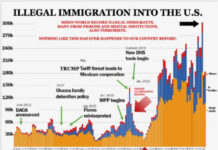Any time we have a political event, such as presidential elections or the election of a governor, immigration becomes one of the main topics of the campaign. The public is overloaded with information about immigration. However, they lack the specifics that would allow them to see the pros and cons of a new immigration law.
The United States has always welcomed immigrants from all over the world. For decades, from the end of the 19th century to the middle of the 20th, Europeans made the United States their new home. Latin Americans began moving to this country at the beginning of the sixties with the Cuban exodus and the migratory flow from Central and South America during the seventies, due to economic crisis and civil wars.
To ensure the control of the immigration flow that began in this country four decades ago, the United States has incorporated several programs offering work visas for people of different backgrounds. These categories include seasonal workers for landscaping, hospitality, and construction; high-skilled temporary workers, such as teachers, engineers, doctors, and nurses; and intra-company transfers from companies outside the country to companies within the fifty states.
Among all the categories named above, high skilled temporary workers are given the opportunity to achieve US citizenship. To do so, they must go through a three-step process order to obtain a legal resident visa or green card. This process can take several years.
Michael Hampton, editor and publisher of Homeland Stupidity, has summarized the process for legal immigration by saying, “People who want to immigrate to the U.S. have to wade through a complex bureaucracy made all the more fragile by its complete reliance on paper forms, some 50 of them, and hope that nowhere in the years-long process does any piece of paper get lost. Frequently the paperwork does get lost, and the immigrant is screwed.”
Last year, the former administration tried but failed to pass another piece of legislation to allow the undocumented immigrants to acquire the same rights that legal residents hold. This legislation intended to grant a special visa called a Z-visa to those immigrants who entered the country before January 1, 2007. It also looked for the implementation of a better border security system that would include hiring more border patrol agents and the erection of a fence throughout the Mexican-American border.
The implementation of a permanent residence process through a point system and an improved guess worker program were two major changes this proposal looked for as well. The point-system process would allow qualified individuals to move to the United States based on their education, English proficiency, and family connections. The guest worker program would bring temporary workers under a two-year visa, renewable up to three times.
For a person who is not a permanent resident of the United States, the only way to be legally entitled to work in this country is through a work visa or an employment authorization. If that person decides to apply for the permanent residency, his employer must get the approval from the Department of Labor (DOL), submit an Immigrant Petition for Alien Worker, and the Application to Register Permanent Residence or Adjustment of Status. The complete process takes up to seven years, depending on the employee’s nationality. If he has married an American citizen or has participated in the annual Diversity Visa Lottery, the process is shorter and follows another route.
“When politicians address the immigration issue, they are mainly thinking of illegal immigrants and how to solve their situation,” said Mayra Garcia, a teacher from Ecuador who teaches English as a Second Language in Saluda, SC. “However, there is another group of people who came to the US legally, following each step and procedure mandated by US immigration laws. Nevertheless, no one is addressing the lengthy processes we go through which on occasions can last up to 20 years.”
The point-system process and the guest worker program would be two positive alternatives for the reform to the immigration system. The point-system process would reduce the waiting time to become a legal resident or get a work visa by allowing the applicant to know immediately if he qualifies to immigrate to the Unites States or not. The guest worker program, on the other hand, would ensure a better control of workers who enter the United States.
“I agree that Homeland Security needs to make sure only the right immigrants get a permanent residency permit to live in the US, ” Garcia said. “However, in my particular case, it has proven to be a long and tiresome process that began almost 5 years ago. I have read about people who have been in the process for over 20 years. That is just too long for a country in dire need of teachers.”
Amid the controversies caused by the immigration issues in the last two years, few businessmen, politicians and immigration advocates dedicate their effort to make legal immigrants feel supported. In a speech delivered, on October 10, 2007 at the Arizona Chamber of Commerce and Industry, Thomas J. Donohue, President and CEO of the U.S. Chamber of Commerce,said, “Legal immigration is as central to our national creed as freedom, democracy, and enterprise. But today, legal immigration is more than just a social value- it’s an economic necessity. We need to dramatically increase the number of visas for highly skilled foreign workers and make the system flexible to market demands.”
Garcia’s hopes were also pinned on another possibility to get the so appreciated Green Card: the Diversity Visa Program (DV-). Each year, about 50,000 visas are given away through a computer generated random lottery. These visas are distributed among countries that have sent less than 50,000 immigrants to the United States in the last five years. Some countries of South America, such as Colombia and Brazil, do not qualify to participate in the lottery. Ecuador, unfortunately, was included in this list in 2007.
In the last three years, the current and past administrations have tried to start debating a new law to legalize the more than 12 million of undocumented immigrants in the United States. However, nobody has pointed out a solution for the thousands of immigrants that are following the right steps to get their residency and furthermore citizenship. As Bob Filner, D-Congressman from California said, “As Congress continues to debate ways to address illegal immigration, we must remember the many hard-working legal immigrants that contribute so much to our nation’s economy and culture.”







